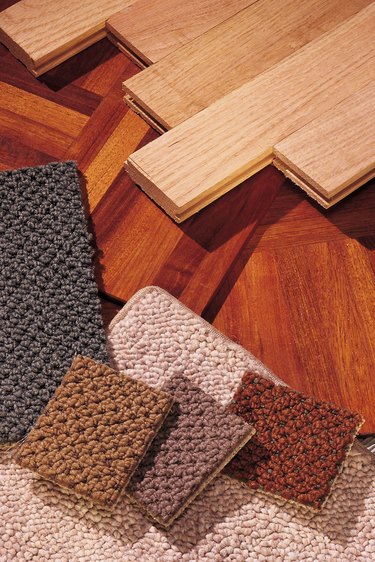Things You'll Need
Broom
chisel
Tape measure
Underlayment pad (if applicable)
Circular saw
Laminate flooring glue (if applicable)
Reducer mold transition piece (cut to your measurements)
Reducer mold track
Hammer Drill
1/4-inch wood dowels
1 1/2-inch masonry screws
Rubber mallet

Reducer molding makes it easy to transition from laminate to carpeting when you lay flooring on concrete. The reducer mold has a curved edge that levels the playing field, so to speak, between the height of carpeting and the height of the laminate. The molding has a track that you will drill into the concrete. The finished installation will give a professional look to how your laminate flooring and carpeting flow from one material to the other.
Step 1
Sweep the concrete floor with a broom to free all debris and dirt. Use a chisel to remove any bumps in the concrete and a steel file to level the space where you removed the bumps.
Video of the Day
Step 2
Measure the width and length of the room with a tape measure. Add 20 percent to your measurements so you have more than an adequate supply. For example, if the room is 10-by-20 feet, purchase enough laminate for a 12-by-24-foot room. If you are installing the laminate as floating flooring, purchase enough underlayment padding to cover a 12-by-24-foot room.
Step 3
Start at the right corner of the room that is farthest away from the doorway. Lay down the underlayment (if applicable) using the glue product recommended by the underlayment manufacturer. Leave a 3/8-inch expansion gap from the perimeter of all walls and existing baseboards and doorway framing and molding to accommodate expansion and contraction of the flooring material.
Step 4
Cut the laminate boards with a circular saw according to your measurements, also leaving a 3/8-inch expansion gap from the edge of the boards to the edge of the walls. Apply glue to the back of the laminate boards (if applicable), lay the boards 3/8 inch from the walls, and work outward.
Step 5
Trim boards that will border the carpeted floors so there is a 1-inch gap from the edge of the carpeting and the laminate boards. This is where you will install the reducer molding track and reducer transition piece between the laminate and the carpeting. The reducer molding will cover the 1-inch gap and the edges of the laminate boards and the carpeting. Trim away any underlayment material so that only concrete shows in the 1-inch space for the transition track.
Step 6
Measure the length of the transition space so you can cut the reducer mold piece and the track. Subtract 3/4 inch from the measurement so you can leave a 3/8-inch expansion gap on the right and left ends. Cut the track according to your measurements. Lay the track in the transition space on the concrete. Use a T-square to make sure that the track is straight. Make marks inside the holes on the track with a pencil at 1-foot intervals, or as close as possible.
Step 7
Drill holes into the concrete with a hammer drill at your marking points with a 1/4-inch masonry bit. Drill the holes about 1 1/2 inches deep.
Step 8
Insert 1/4-inch wooden dowels into the holes. Use a hammer to tap the dowel into place. Break off the top of the dowel with a chisel so it is flush with the top of the concrete.
Step 9
Place the track in the transition place so the holes in the track line up with the dowel holes. Use 1 1/2-inch masonry screws to screw the track into the dowel-covered holes.
Step 10
Center the T-mold piece above the track, and lower and snap it into the track. Use a rubber mallet to tap on the piece so that it snaps in firmly to complete your laminate and carpet transition project.
Tip
If you are transitioning the laminate and carpeting between a doorway area, center the reducer mold in the door frame for a neat look when the door is closed.
Video of the Day
- World Floor Covering Association: How to Install Laminate Flooring
- Balboa Flooring: Floor Install Tips -- Transitions Between Flooring
- Balboa Flooring: T-Molding, Stairnose, Reducer Strip, Quarter Round, Threshold Wood Floor Molding
- Laminate Flooring: Laminate Installation Guide
- Ron Hazelton: How to Put In a Laminate Floor
- Laminate Flooring Installed: Finishing Carpet to Laminate Transition
- Find Any Floor: Installing Laminate Flooring Around Trims and Transitions
- Laminate Flooring Installed: Installing Laminate Transitions